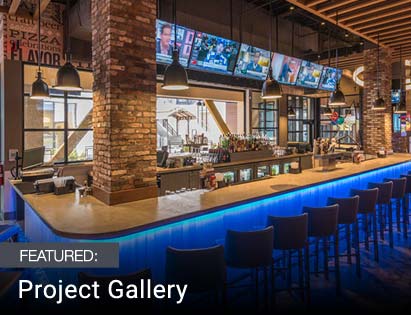Resources
LED Rope Lights: Vertical or Horizontal?
LED rope lights come with the LED diodes in two different configurations: vertically-oriented and horizontally-oriented. And it’s important to choose the right one. But what’s the difference and why would you want to choose one over the other? The choice comes down to application, and the specific needs of your project.
You can read more about the difference between the two styles here, but here’s a quick summary:
Horizontal Bulb Orientation
Vertical Bulb Orientation
Each style has its pros and cons. So when do you want to use a “horizontal” rope light? And when is a “vertical” rope light your best choice?
 In indirect applications where the LED rope light will be hidden from view, but you want to see the light output reflected off of adjacent surfaces, such as cove lighting, your best bet is horizontal. Horizontal-orientation provides uniform, omnidirectional light output, making it suitable for applications where you need a continuous line of line, and don’t want to see any hot spots.
In indirect applications where the LED rope light will be hidden from view, but you want to see the light output reflected off of adjacent surfaces, such as cove lighting, your best bet is horizontal. Horizontal-orientation provides uniform, omnidirectional light output, making it suitable for applications where you need a continuous line of line, and don’t want to see any hot spots.
Examples for horizontally-oriented LED rope lighting include:
 For direct applications, where the LED rope light is in direct view of the users/public, you are often going for a visual statement, where you want the rope light to make an impact. In these applications, you want to use a vertical orientation with directional light. The outward facing LEDs in vertically-oriented rope lights are very bright and provide a more “attention-grabbing” light than the more subdued horizontal-oriented rope lights. With vertical rope lights, care must be taken with how the rope light is installed, so that the LEDs are always facing toward your target audience. If the LEDs in the rope light are facing backwards at any point in your installation, the perceived light output will drop considerably in that area. But if you need your lights to pack a “punch” and need your light to reach as far as possible, go with vertical.
For direct applications, where the LED rope light is in direct view of the users/public, you are often going for a visual statement, where you want the rope light to make an impact. In these applications, you want to use a vertical orientation with directional light. The outward facing LEDs in vertically-oriented rope lights are very bright and provide a more “attention-grabbing” light than the more subdued horizontal-oriented rope lights. With vertical rope lights, care must be taken with how the rope light is installed, so that the LEDs are always facing toward your target audience. If the LEDs in the rope light are facing backwards at any point in your installation, the perceived light output will drop considerably in that area. But if you need your lights to pack a “punch” and need your light to reach as far as possible, go with vertical.
Examples for vertically-oriented LED rope lighting include:
So are vertical or horizontal rope lights best for your project? Not sure? Reach out to us and we’ll help you out.
You can read more about the difference between the two styles here, but here’s a quick summary:
Horizontal Bulb Orientation
- Individual LEDs placed parallel to the length of the rope light so that they face the adjacent LEDs
- Better uniformity of light, but with less light output
Vertical Bulb Orientation
- Individual LEDs placed perpendicular to the length of the rope light so that they face outward
- Brighter light output, but with more hot-spotting on adjacent surfaces
Each style has its pros and cons. So when do you want to use a “horizontal” rope light? And when is a “vertical” rope light your best choice?
Indirect Applications
 In indirect applications where the LED rope light will be hidden from view, but you want to see the light output reflected off of adjacent surfaces, such as cove lighting, your best bet is horizontal. Horizontal-orientation provides uniform, omnidirectional light output, making it suitable for applications where you need a continuous line of line, and don’t want to see any hot spots.
In indirect applications where the LED rope light will be hidden from view, but you want to see the light output reflected off of adjacent surfaces, such as cove lighting, your best bet is horizontal. Horizontal-orientation provides uniform, omnidirectional light output, making it suitable for applications where you need a continuous line of line, and don’t want to see any hot spots.Examples for horizontally-oriented LED rope lighting include:
- Cove lighting
- Back lighting
- Decks and railings (if hidden from view)
- Trade show lighting (if all angles of rope light are visible to audience)
Direct Applications
 For direct applications, where the LED rope light is in direct view of the users/public, you are often going for a visual statement, where you want the rope light to make an impact. In these applications, you want to use a vertical orientation with directional light. The outward facing LEDs in vertically-oriented rope lights are very bright and provide a more “attention-grabbing” light than the more subdued horizontal-oriented rope lights. With vertical rope lights, care must be taken with how the rope light is installed, so that the LEDs are always facing toward your target audience. If the LEDs in the rope light are facing backwards at any point in your installation, the perceived light output will drop considerably in that area. But if you need your lights to pack a “punch” and need your light to reach as far as possible, go with vertical.
For direct applications, where the LED rope light is in direct view of the users/public, you are often going for a visual statement, where you want the rope light to make an impact. In these applications, you want to use a vertical orientation with directional light. The outward facing LEDs in vertically-oriented rope lights are very bright and provide a more “attention-grabbing” light than the more subdued horizontal-oriented rope lights. With vertical rope lights, care must be taken with how the rope light is installed, so that the LEDs are always facing toward your target audience. If the LEDs in the rope light are facing backwards at any point in your installation, the perceived light output will drop considerably in that area. But if you need your lights to pack a “punch” and need your light to reach as far as possible, go with vertical.Examples for vertically-oriented LED rope lighting include:
- Architectural exterior border lighting
- Signage
- Decks and railings (if in direct view)
- Trade show lighting (if audience only sees rope light from straight on)
So are vertical or horizontal rope lights best for your project? Not sure? Reach out to us and we’ll help you out.











